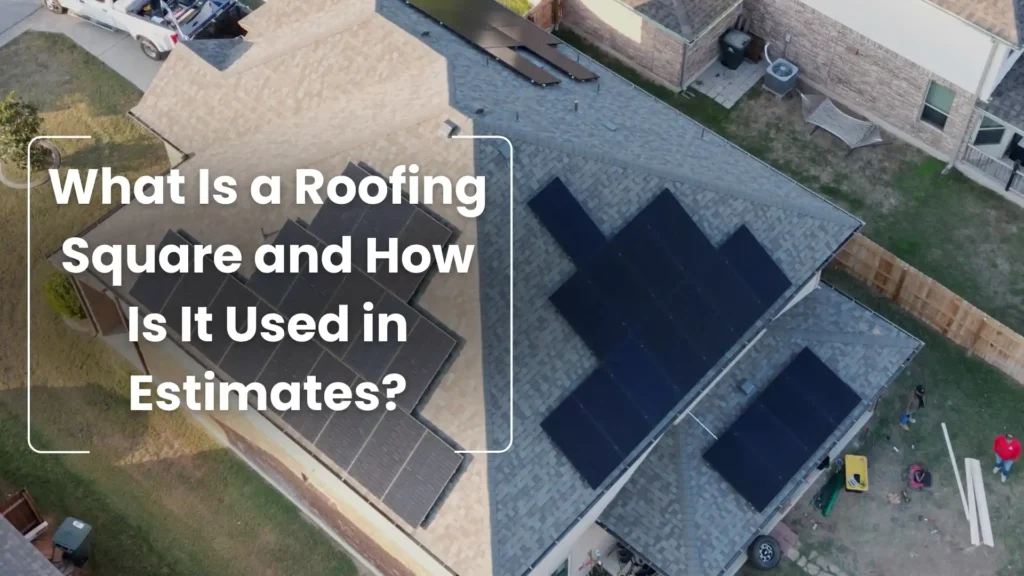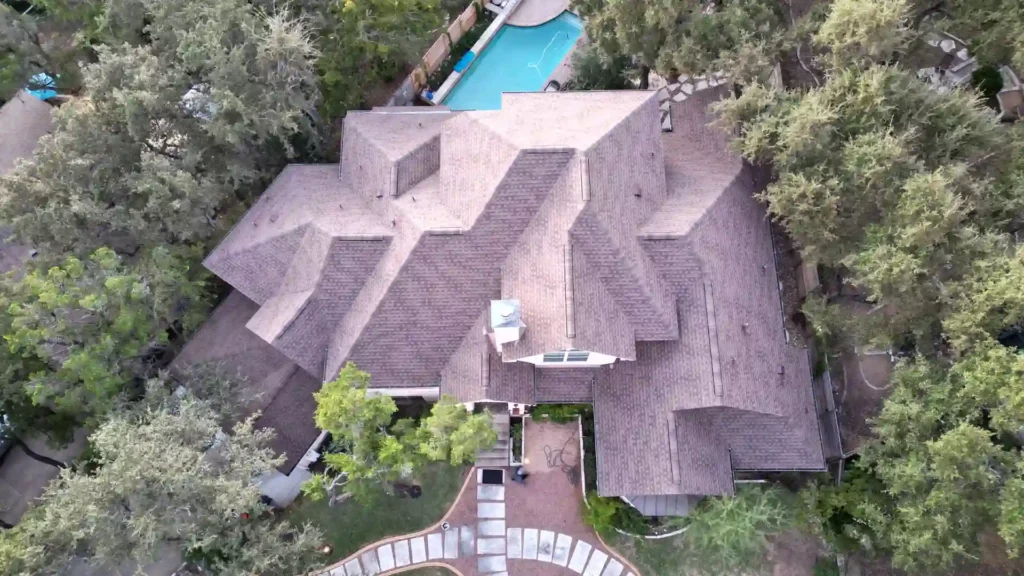What Is a Roofing Square and How Is It Used in Estimates?

Professional roofers use unique language that many home and business owners may not understand. A “roofing square” is one of those terms that you may hear roofers using, but may not necessarily know what it means. It’s not a foreign language or a confusing mathematical system.
A roofing square is a unit of measurement used by professional roofing contractors. Experts use this unit to help them measure and estimate the materials needed to complete a roofing job. Understanding what this measurement means can help you better understand the scope of your next roofing project.
What Is a Roofing Square?
A roofing square is a unit of measurement used in the roofing industry. It helps roofers estimate materials and costs quickly. A roofing square is an area of the roof that measures 10 by 10 feet or 100 square feet. A roofing contractor would call a roof that is 2,000 square feet 20 squares.
Using roofing squares as a unit of measurement for roofing projects simplifies the materials ordering process. Using squares as the standard measurement form also helps contractors deliver quick and consistent estimates to clients.
Why Roofers Use Squares Instead of Square Feet
Why do roofers need a special unit of measurement for their projects instead of simply using square feet? The answer is that it helps simplify calculations and material ordering for roofing projects. One roofing square equals 100 square feet, making calculating space, ordering materials, and generating estimates fast and easy. Other reasons professional roofers use squares instead of square feet include:
It Keeps Measurements Consistent
Roofs come in many shapes and angles. Not all roofs are flat and easy to measure. Measuring in squares creates a simple, universal way to discuss size and avoids confusion between homeowners, roofers, and suppliers. It also makes the math easier to do in a contractor’s head.
It Speeds Up Material Ordering
The roofing industry packages shingles, underlayment, and other materials using squares. Using squares as the default measurement helps roofers quickly order the right amount of materials.
It Reduces Errors
Using squares helps prevent miscommunication and mistakes. It ensures everyone, from suppliers to contractors, is on the same page during a roofing project.
It Reduces Waste
Measuring and calculating in squares also allows contractors to avoid waste, keeping a job more cost-effective and sustainable. They can order the materials they need and avoid excessive leftovers.
How to Calculate Roofing Squares
One roofing square is equivalent to 100 square feet. So, how do roofers calculate roofing square, especially on roofs with steep slopes or hard-to-measure areas? Roofing experts determine the number of roofing squares by measuring each plane’s length and width on a roof. Then they can multiply the two numbers to get the square footage of each particular plane. Here’s the step-by-step process:
Measure Roof Length and Width
A roofer measures the length and width of each flat section of a roof. They then multiply those numbers together to get the area in square feet. If a homeowner’s roof measures 20 feet long and 15 feet wide, 20 x 15 = 300, so the area is 300 square feet.
Add All Sections Together
A residential roof tends to have multiple areas or planes, not just one large, flat section. A roofer repeats the measurement step for every section and adds all the square footage for the total roof area.
Divide by 100
The contractor takes the total square footage and divides it by 100. If the sum of all measurements is 2,000 square feet, 2,000 ÷ 100 = 20 roofing squares. This calculation gives you the total number of squares for the roof.
Factor in Roof Pitch
Sometimes, when a roof has a steep pitch, a contractor multiplies by a pitch factor to account for the extra surface area. The roof slant can impact the pitch factor, so it is best to ask a professional roofer for their opinion.
More About Roofing Squares
Roofing materials like shingles are typically sold by manufacturers by the bundle. Synthetic shingles made with rubber, plastics, or composites are sold in bundles that cover one square. However, asphalt shingles can come in bundles of three to four and only cover about one-third of a square. Asphalt shingles tend to be heavier. Since bundles must be easily lifted and moved around a job site, manufacturers limit the number of asphalt shingles in a bundle, making them easier to handle.
Metal roofing panels are generally sold in panels or sheets that cover one square. Clay and concrete tiles are also sold in boxes that cover one square. Since most roofing materials are packaged in the standard “roofing square” size, using squares makes it faster and easier to order the right materials and supplies in the right quantities.
Measuring and ordering in squares also helps homeowners because a contractor can more quickly generate an accurate job estimate. As a homeowner, you get a quote you can count on to be fair and consistent.
Homeowners should also understand that contractors always account for the potential of damaged shingles or the need for extra materials in their estimates. Twenty roofing squares may be the actual size of a roof, but additional materials may be needed to complete a job.
Contact One of Texas’s Most Trusted Residential Roofing Pros with RoofsOnly.com
Investing in a roof is a significant financial and time commitment. As a homeowner, you want to know you are getting high-quality service at an affordable price. Understanding how a roofing expert measures your roof offers homeowners the transparency they want in the roofing replacement process. The experts at RoofsOnly.com pride themselves on quality installation, friendly service, and building honest relationships with Texas homeowners. Contact us today to arrange for a free inspection and estimate. We are ready to evaluate your situation and give you a fast and accurate quote for your roofing job.
Related Posts:


